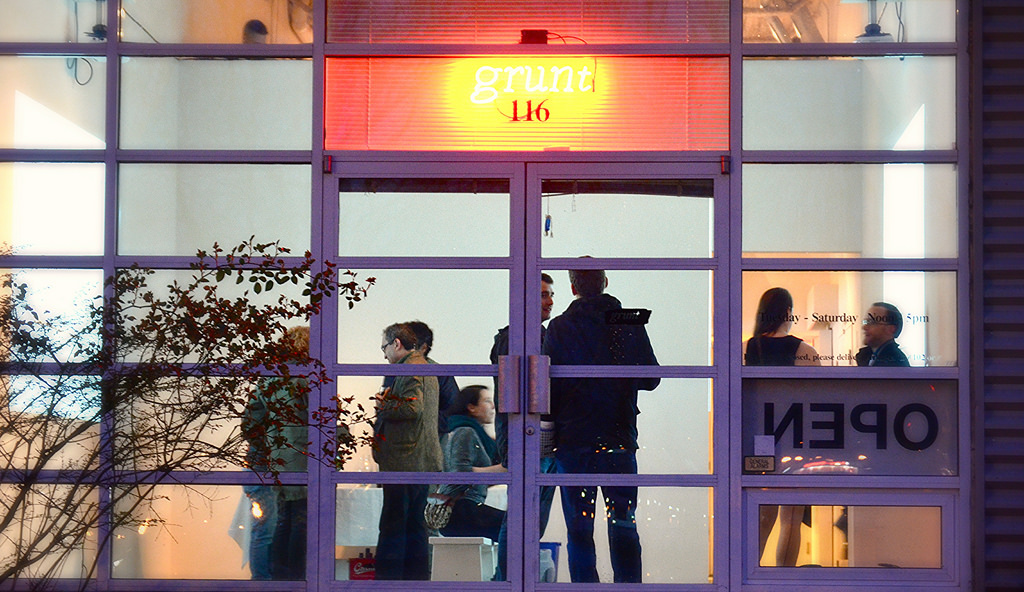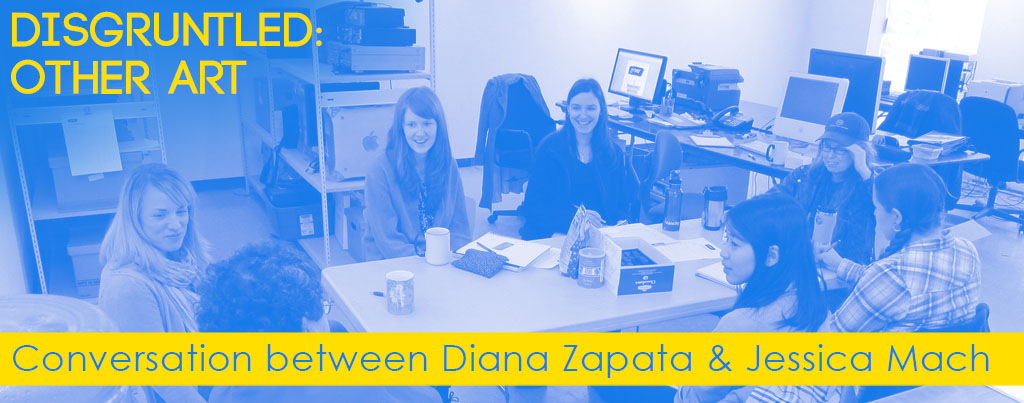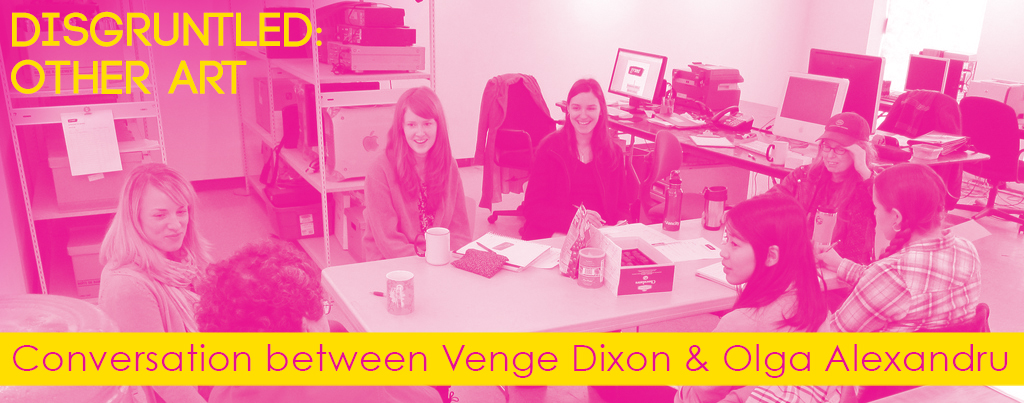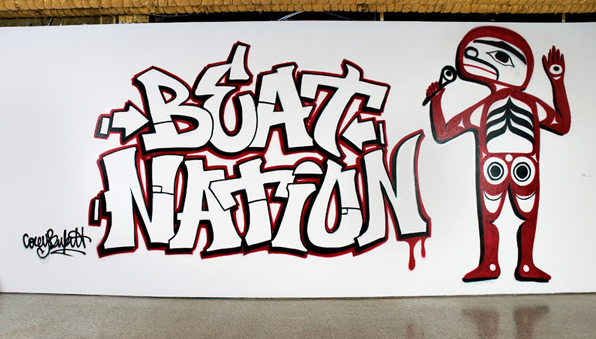Vancouver Independent Archives Week 2015 wraps…more to come soon.
A big thank you to Vancouver Foundation, VIVO, the Western Front, all the artists and presenters, volunteers, and everyone else who helped make Vancouver Independent Archives Week 2015 a big success, and a special shout out to everyone who came out for an event or two or six this week. We are very pleased by and proud of the diverse audience that places value in our archives. Stay tuned to this page for more news from the grunt Archives including what we are planning for VIAW 2016 ;~)

Still from the launch of the Western Front’s newly digitized Literary Collection.
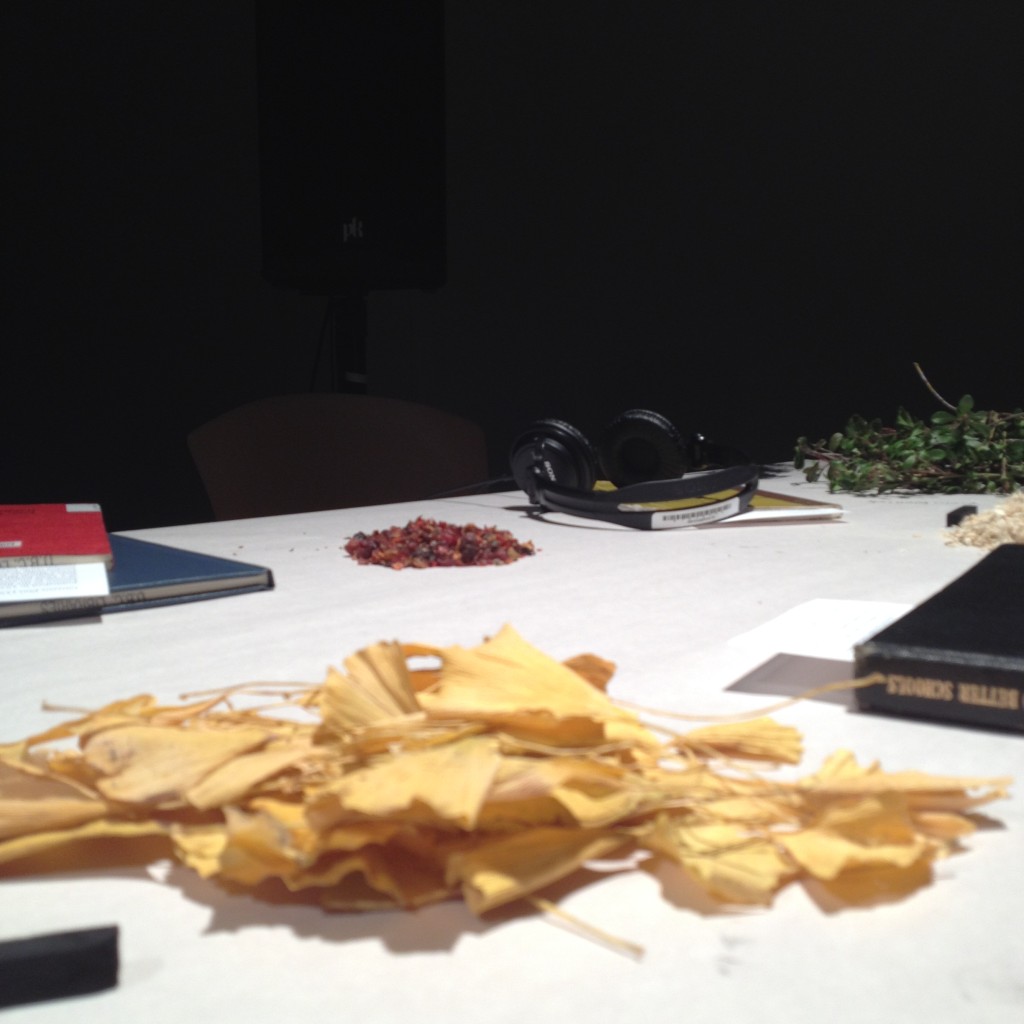
Installation of Stacey Ho’s audio piece: A few ways to learn a couple things at VIVO.
Double Book Launch featuring Henri Robideau’s Eraser Street and Ethnographic Terminalia’s Terminus: Archives, Ephemera, and Electronic Art e-zine for Vancouver Independent Archives Week 2015
6pm Wednesday November 25th at grunt gallery
grunt is pleased to release Henri Robideau’s newest book Eraser Street: Hubris, Humility, and Humanity in the Making of a City, the catalogue for his exhibition of the same name earlier this year, featuring an essay written by Clint Burnham. Books will be for sale and the artist will be in attendance.
“Viewing Henri’s work is like taking a walk through Vancouver with an old master pointing out the sights of the city. Many are sites of resistance that show the struggle for affordable housing that has been increasingly lost over the last 40 years. The hand-written commentaries tell it all as they lay out with no holds barred the movement from the 1970s hippies to the present day hipsters steadfastly fighting to protect their communities from the onslaught of redevelopment”
Glenn Alteen, Curator’s Introduction
Henri has been photographing exhibitions at grunt for years and the archive is rich with his documentation work. Through his lens he has told the story of the grunt’s exhibition history along with so many other stories of Vancouver.

Henri Robideau is a photographer and cultural narrator. His life in photography spans nearly five decades – the medium providing both his profession and his means of artistic expression. He is best known for The Pancanadienne Gianthropological Survey, a two-decade record of eccentric Canadian landmarks; Flapjacks & Photographs, the biography of early British Columbia photographer Mattie Gunterman; and 500 Fun Years, the story of colonialism. Panoramic image collages, holographic text and narrative sequences are the hallmarks of his work, which has been exhibited and collected nationally and internationally. Since 1979, he has taught photography in half a dozen Canadian universities and is currently a sessional instructor at Emily Carr University. For the past twenty years his large format photographic skills have been in demand by Canada’s leading artists, whom he has assisted in the production of their work. He is currently exploring digital colour technology, alternative means of perpetual photographic presentation and writing anecdotal stories about the ironic tragedy of human existence.
grunt is also excited to launch the e-zine version of Ethnographic Terminalia’s Terminus: Archives, Ephemera, and Electronic Art. Produced in print following the workshop of the same name at VIVO Media Arts during ISEA 2015, Terminus documents the presentations and collaborative process of attendants responding to electronic art works and theoretical frameworks that disrupt material, figurative, discursive, cultural, and political manifestations of the archive.
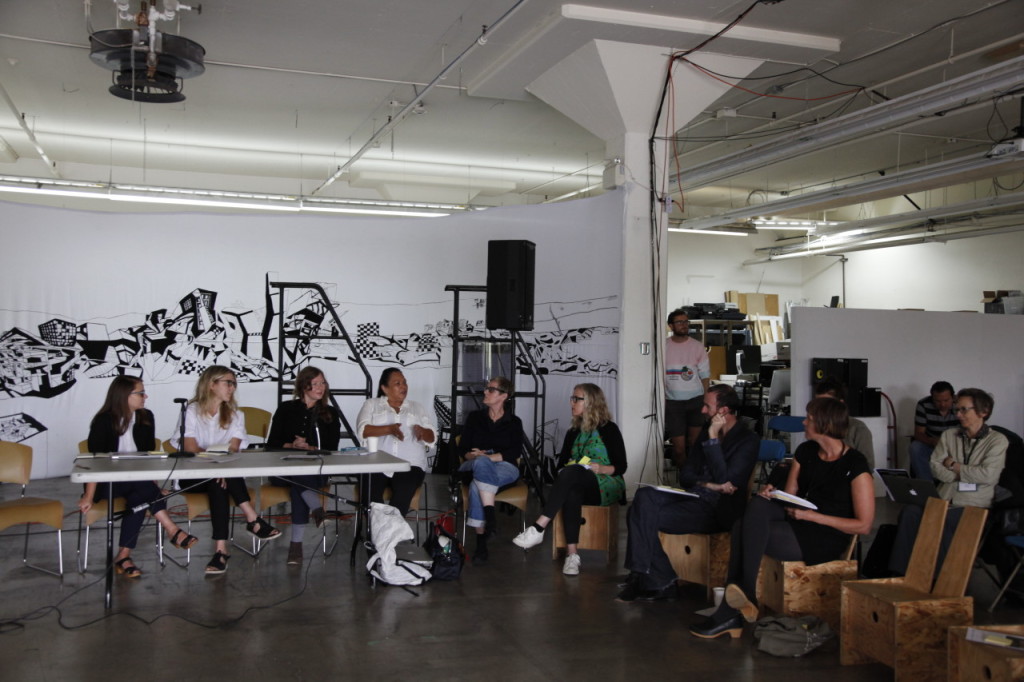
The workshop featured a presentation by Britt Galpen and Yasmin Nurming-Por in collaboration with grunt gallery’s Tarah Hogue on the concurrent exhibition Arctic Noise by artist Geronimo Inutiq, whose work tapped into the Isuma Archive as a means of responding to Glenn Gould’s celebrated composition “The Idea of North”.
Also presenting was Gabriela Aceves Sepúlveda speaking on her video piece Remdiating Mama Pina’s Cookbook which is screening in grunt’s Media Lab all week. Also in conjunction with Vancouver Independent Archvies Week, Gabriela will appear on the Artists in the Archive panel on Thursday November 26th, 7pm at the Western Front.
Kate Hennessy and Trudi Lynn Smith from Ethnographic Terminalia will be in attendance, along with Tarah Hogue.
Ethnographic Terminalia is a curatorial collective grounded in a commitment to pushing the boundaries of anthropological scholarship and contemporary art through interdisciplinary exhibitions. Since 2009 we have been curating group exhibitions in major North American cities (Philadelphia, New Orleans, Montréal, San Francisco, New York, and Chicago). These projects demonstrate how contemporary artists, anthropologists, and institutions are engaging with ethnographic methodologies and art. The majority of the exhibitions have been mounted as ‘para-sites’ or ‘off-site installations’ to the annual meetings of the American Anthropological Association. They have facilitated and championed works that explore new media, new locations, and new methods in anthropology and cultural studies. The collective has worked with more than 110 artists and anthropologists to date, generating ongoing creative collaboration between anthropological researchers and practicing artists. Our exhibitions and the works in them have been widely reviewed and publicized in both discipline-specific journals and the popular press.
Volunteer Spotlight: Mallory Gemmel
One of the great things about working in the grunt archive is meeting the sharp and curious folks who come to research and volunteer their time with our collection. Mallory Gemmel is a 4th year Photography/Curatorial Studies student at Emily Carr who has been completing an internship in the archives this fall. She has been digitizing slides, prints, and text material and uploading it to our online archives database The Activation Map. Mallory wrote this reflective piece after coming across an exhibition that really spoke to her, Anna Banana’s Bananapost: 20 Years of Fooling Around with A. Banana (1990):
postbanana at grunt: 20-45 Years of Fooling around with A. Banana
Mallory Gemmel
With a rich history and an organic and intuitive attitude, grunt has existed and remained as a space devoted to the arts community in Vancouver – expanding its arms to artists, curators, historians, archivists, students and many more. To an individual with keen interest of stepping into the community, the grunt’s life is unique, and it is rewarding to experience firsthand the three-decade continuum of contribution to Vancouver’s art identity.
Volunteering over the past weeks, I have had the opportunity to search and discover the vibrancy of the grunt’s archive, as a part of their Activating the Archive initiative. The project aims to digitize material from the archive and upload this content to their online database The Activation Map, increasing the access to information on past exhibitions and events to the public.
Sifting through documents, photographs, slides and publications I have been exposed to the work and collaborations of countless artists.
An artist whose work I have been digitizing and uploading since the coming to grunt is Anna Banana. Born in Victoria in 1940, Anna Long is a conceptual mail and performance artist under the alter ego of Anna Banana – a woman fascinated by bananas. Her work pokes fun at cultural phenomena, incorporating both performance and mail art (stamps, postcards, trading cards) that blurs the line between performer/audience and performance/ real life.
In February of 1990 grunt held an exhibition of Banana’s work, entitled Bananapost: 20 Years of Fooling Around with A. Banana. The whimsical show consisted of an accumulation of Banana’s visual work: stamps, drawings, paintings and collage. Alongside this material she conducted sound performances and introduced video documentation of her 1975 and 1980 Banana Olympics. The show also included documentation of her many publications: The Banana Rag, VILE Magazine and International Art Post to name a few. At the time, her presence as a mail artist was internationally recognized. She was interested in using the stamp as an art form and created a limited edition stamp sheet and book for the retrospective at grunt.
grunt’s archive is proof of the vitality of art within Vancouver, both in the past and today. Calling up reference to new work, the archive holds documentation of artists who are thriving and very much engaged within the community. Anna Banana is currently exhibiting another retrospective at the Art Gallery of Greater Victoria in collaboration with Open Space entitled, appropriately enough, 45 Years of Fooling around with A. Banana.
This living and growing connection that grunt and it’s archive has to the present life of the artistic community was something I was unaware of when I began working in the space. Searching through numerous shows, names, and work, Anna Banana is only one example of a name I came across both in the archive as well as daily discussion with the individuals at the gallery. It is exciting and encouraging seeing that past efforts of community and artistic engagement continue to fortify the contemporary art scene, knowing archival materials will continue to hold purpose and importance within the understanding and production of art.
I am excited and eager to continue to explore the contents of the grunt’s archive – the entirety of its holdings, and its overall distinction as a well-respected center for art within Vancouver.

If you are interested in researching in the grunt archives or would like to find out more about volunteering, please get in touch dan@grunt.ca
Dr. Gabriela Aceves Sepúlveda at Vancouver Independent Archives Week 2015
grunt gallery is pleased to present Gabriela Aceves Sepúlveda, Assistant Professor at SFU’s School of Interactive Arts and Technology at Vancouver Independent Archives Week.
Dr. Sepúlveda will be presenting as part of the Artists in the Archive panel, hosted by the Western Front on Thursday November 26th at 7pm.
Archives at artist-run centres are a unique resource for artists and the community at large. Indispensable as sites for engagement with histories, they also offer space for creativity and new productions. “Artists in the Archive” will feature presentations by artists who are actively working with archives. Discussions will be aimed at linking the actions and strategies of artist-run centres, who have made significant strides to maintain their archive, with the ongoing work of artists who rely on the preservation of these vulnerable materials.
grunt will be exhibiting her piece Remediating Mama Pina’s Cookbook in our Media Lab from Saturday November 21st through Saturday November 28th. Drop by anytime we are open (Tues-Sat 12pm-5pm) to have a look.
In addition, grunt will be hosting a double book launch on Wednesday November 25th at 6pm for Henri Robideau’s Eraser Street and Ethnographic Terminalia’s e-zine Terminus: Archives, Ephemera, and Electronic Art, the output from their workshop at VIVO in August during ISEA 2015. Dr. Sepúlveda was a presenter at the workshop and her work is featured in the e-zine.

Vancouver Independent Archives Week 2015 publication
The Western Front, VIVO Media Arts, and grunt gallery have collaborated on a special publication for Archives Week. Pick up your copy at any of the Archives Week events listed within and enjoy the intangible version in the meantime.
grunt gallery and the Native Education College present Dr. Kristin L. Dowell at Vancouver Independent Archives Week Monday November 23rd.

Dr. Kristin L. Dowell will share her presentation Artist-Run Archives/Indigenous Art Histories at the Native Education College, Monday November 23rd, 12PM.
Over the last two years I have embarked on research in the grunt gallery’s archive to explore the vital role of this artist-run centre in supporting the creation and exhibition of contemporary First Nations art. Social memory, cultural protocols, radical voices, and a range of First Nations contemporary art practices emerge, composing vibrant Indigenous art histories that serve as alternatives to dominant narratives about Vancouver’s art world. In this talk I will share several examples uncovered in my research that reveal the invaluable resource of the grunt gallery’s archives for understanding the impact of contemporary First Nations art within this artist-run centre and the contributions this rich archive makes to a deeper knowledge of Canadian art practice.
grunt is excited to have Dr. Dowell back in Vancouver and to partner with the Native Education College for this event. More Archives Week events and details to come soon.
Dr. Kristin Dowell is an Associate Professor of Anthropology at Florida State University whose research explores the intersections of media technology, artistic practice and activism for Indigenous rights and social justice. A Fulbright Scholar, she received her PhD in cultural anthropology with a certificate in Culture and Media from New York University in 2006. For the last fourteen years she has engaged in collaborative community based research with Aboriginal filmmakers, artists and activists in Vancouver, Canada. She is the author ofSovereign Screens: Aboriginal Media on the Canadian West Coast (2013) an ethnography of Aboriginal visual sovereignty through on-screen film aesthetics and off-screen production practices. Her articles have appeared in the journals American Anthropologist, Anthropologica, and Transformations and in edited volumes, including Native Art of the Northwest Coast: A History of Changing Ideas, winner of the 2015 Canada Prize in the Humanities. She is currently working on a research project that explores the social history and contemporary practice of Aboriginal experimental film and media art in Canada.
grunt gallery, Western Front and VIVO Media Arts Centre are excited to host an inaugural Independent Archives Week from November 22–28, 2015.
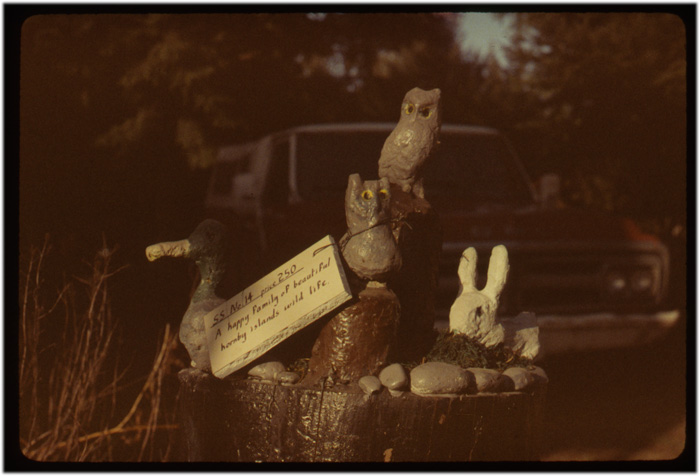
This week will contain interactive programming to engage the Vancouver community and raise awareness with artist-run centre archives. Tours, performances, public talks, screenings, publications and hands-on youth & family archive workshops will be a part of the activities planned.
Vancouver artists have a long and recognized history as cultural innovators, activists and archivists – their work, preserved in the distinct collections of the participating centres has captured moments in Vancouver’s cultural evolution, while at the same time often becoming a catalyst for societal change. Archival collections, at ARCs, provide a unique “grassroots” window into the alternative and social histories that shaped our city (urban Aboriginal, visible minority, LGBTQ, feminist, social justice, environmental, “counter-cultural”) – as seen through the lens of our artists as observers and commentors. Our project emphasizes these relationships between contemporary culture and social movements (and how they spur social change), draw attention to shared experiences/struggles across communities that are diverse in age, ethnic background, sexual orientation, and gender.
The distinct curatorial focus of each participating centre makes each of these collections unique – it is these differences that will be celebrated through programming that increases public access to these archives. Our current digital age has made us all into our personal “archivists” and “curators” – selecting and preserving photos, video and text that inspire and motivate us. Archives week will connect residents to a greater collective community/art heritage.
More info to come.
DIG Revisited | Posted September 28, 2015
Written by Dan Pon
The idea for Vancouver Independent Archives Week began in December 2014, with a Saturday afternoon of presentations and discussions called DIG, showcasing recent projects around grunt’s and other artists’ archives and inviting participants to tour the grunt archives and enjoy refreshments in grunt’s kitchen. Despite some nasty weather, folks trickled in and by mid afternoon we had a full house in the gallery’s neighbouring amenity space.
Starting things off with a short performance, Igor Santizo and Emilio Rojas gave a talk on their May 2013 project ThisPlace Vancouver, a piece that they, along with fellow artist Guadalupe Martinez, conceived of as a response to Background / Vancouver, a 1972 photo mapping expedition of the city done by Michael de Courcy, Taki Bluesinger, Gerry Gilbert, and Glenn Lewis. ThisPlace culminated in an exhibition at grunt and a companion website that includes a link to the original Background / Vancouver site.
In advance of the massive Mainstreeters exhibition at the Satellite Gallery that would open a month later, project co-curator Allison Collins gave DIG attendees a sneak preview of digitized material from artist Paul Wong and his peers’ personal archives that told the story of a group of friends coming of age in East Van in the 70s, the origins of the Main Street art/bohemian scene, and Wong’s rise to art stardom. Allison’s insights and anecdotes on her and Michael Turner’s research and curatorial process made for an engaging behind the scenes look at the work that went into this rich retrospective. You can check out the Mainstreeters project site and video documentary here.
Finally, artist Julia Feyrer spoke on her ongoing residency project Kitchen. Curated by Vanessa Kwan as part of grunt’s 30th Anniversary programming, Kitchen reimagined the grunt kitchen prior to its renovation into our Media Lab space. Once the center of social life at grunt, the kitchen was reconstructed in the gallery space from archival photos, stories and ephemera, and reactivated with a series of workshops, curatorial texts by Vanessa, and, of course, Julia’s own spin on grunt’s annual solstice party that included the now infamous falling man stunt. More info on Kitchen here.
DIG was a great event, but we knew we had to do it bigger and better in 2015, so this November we are partnering with our longtime contemporaries VIVO Media Arts and the Western Front to bring you a full week’s worth of archive programming. We look forward to seeing you there.
Dan Pon
grunt archives

Sept 23, 2015: WestEnder Article | grunt gallery Throws Open the Archives

Dan Toulgoet photo
“Because the nature of our collections is so different, we’re all doing it very differently. It’s an interesting conversation going on between these three spaces,” explains grunt co-founder and program director Glenn Alteen. “Their emphasis is on saving, because so much of their stuff is from the ‘70s and has become very brittle, whereas our stuff is more from the late ‘80s and early ‘90s, so we’re not on that same salvage paradigm.”
Funded by a Field of Interest grant from The Vancouver Foundation, all three centres will present programming throughout the week of Nov. 22-28 with the goal of engaging the public and raising awareness around the operation and challenges that come with these types of non-traditional art archives.
“The archives become more and more important as time goes on,” says Alteen. “It’s really kind of the crux of what we do, because it allows us to make connections over decades.”
Read the entire article here.
July 24, 2015 | Funding Announcement for Archives Week

Central Vestiges by Tom Knott, May 1988
